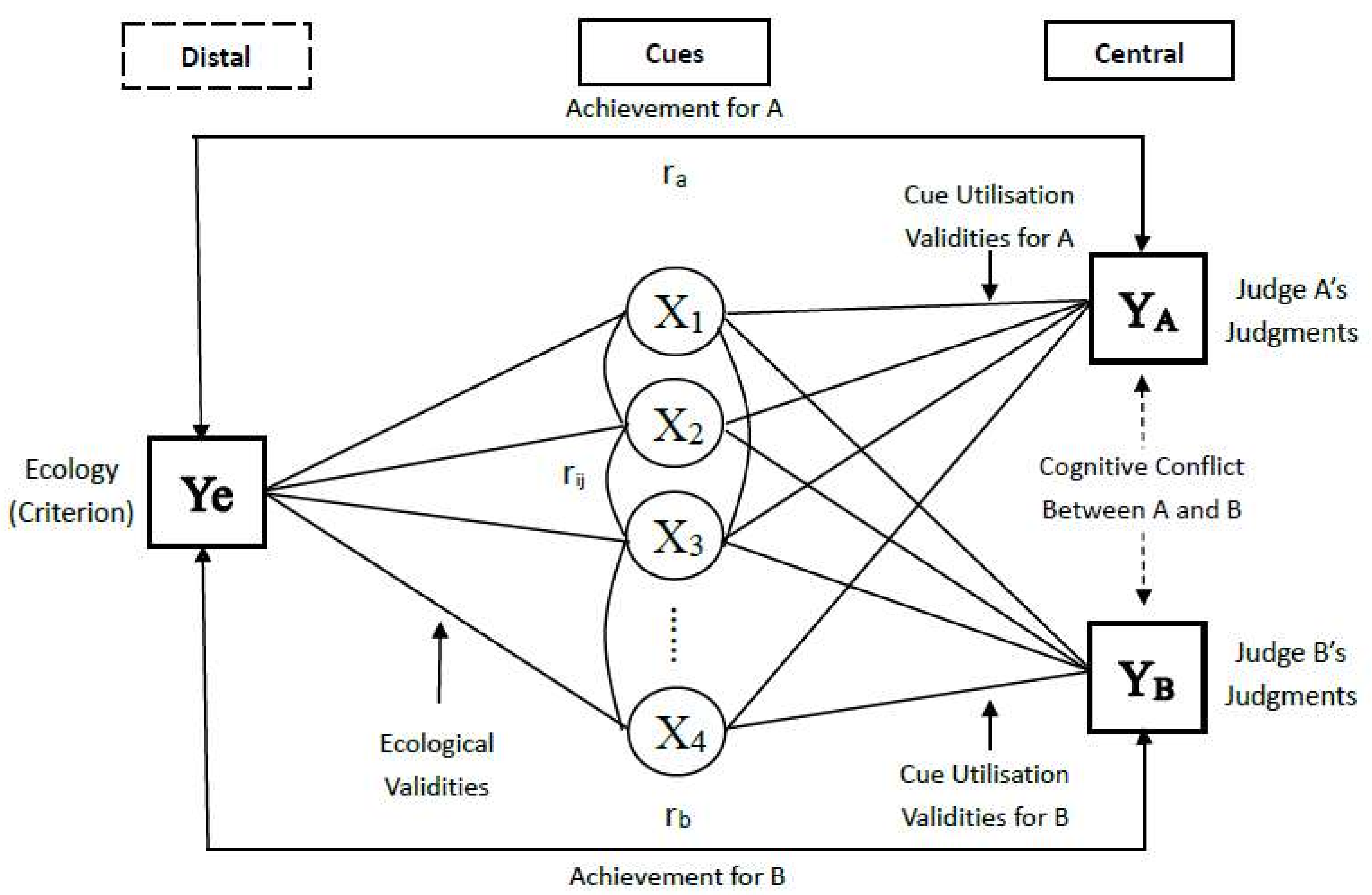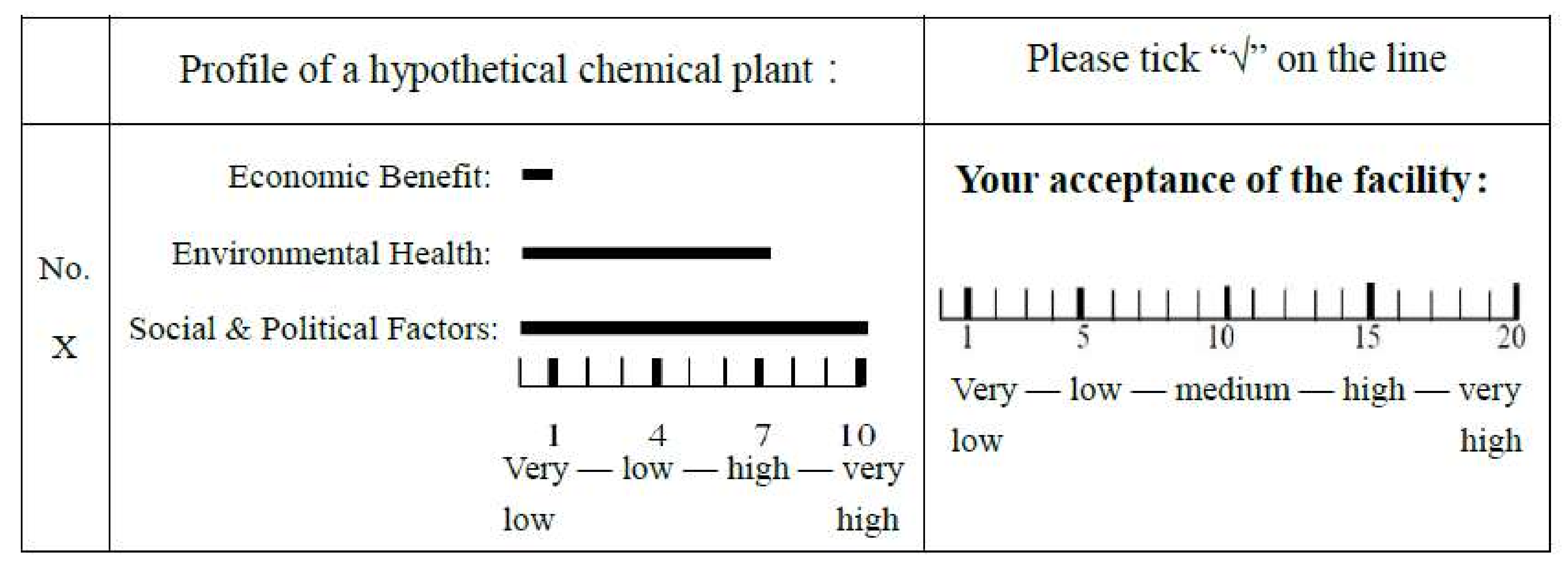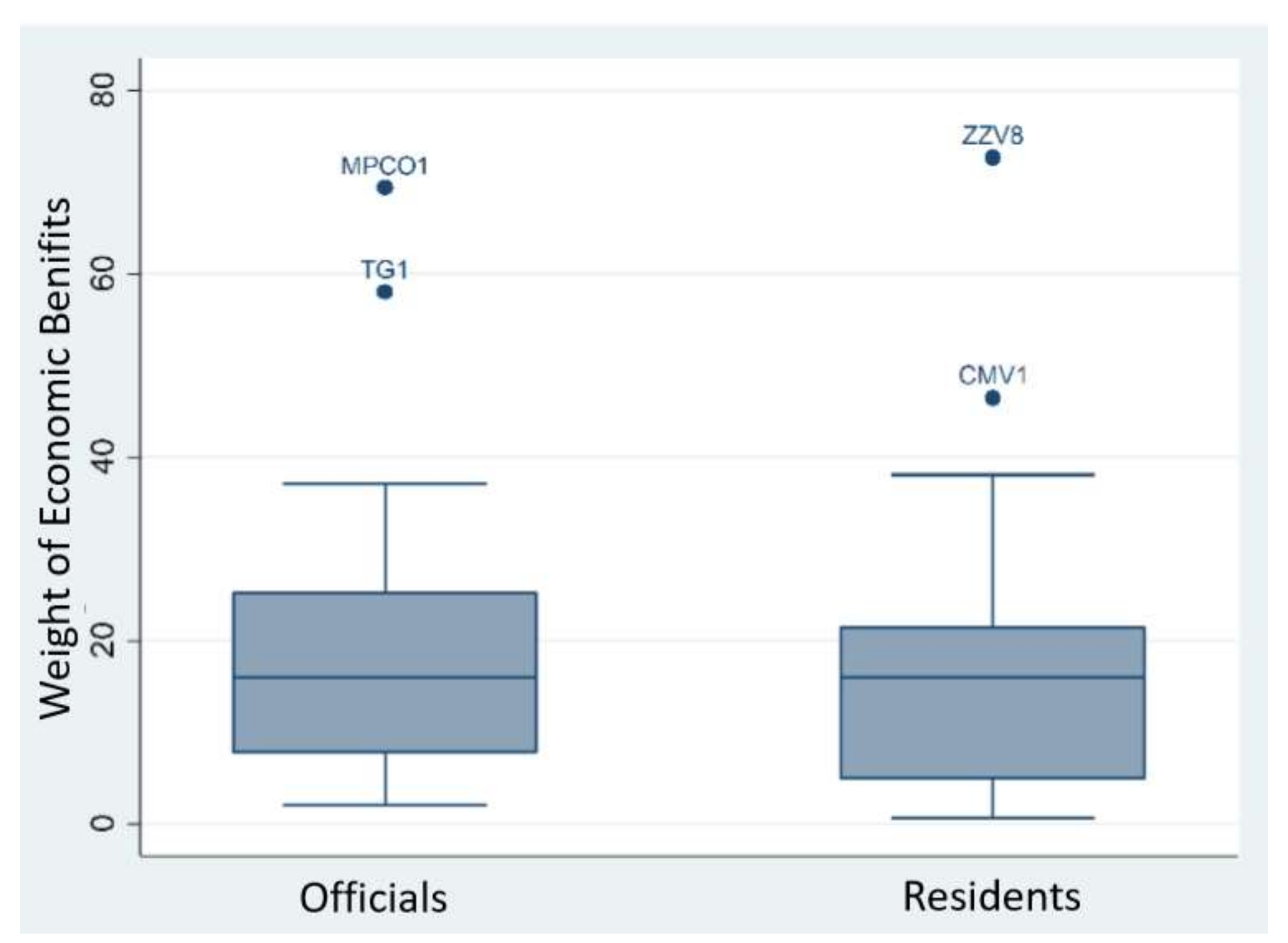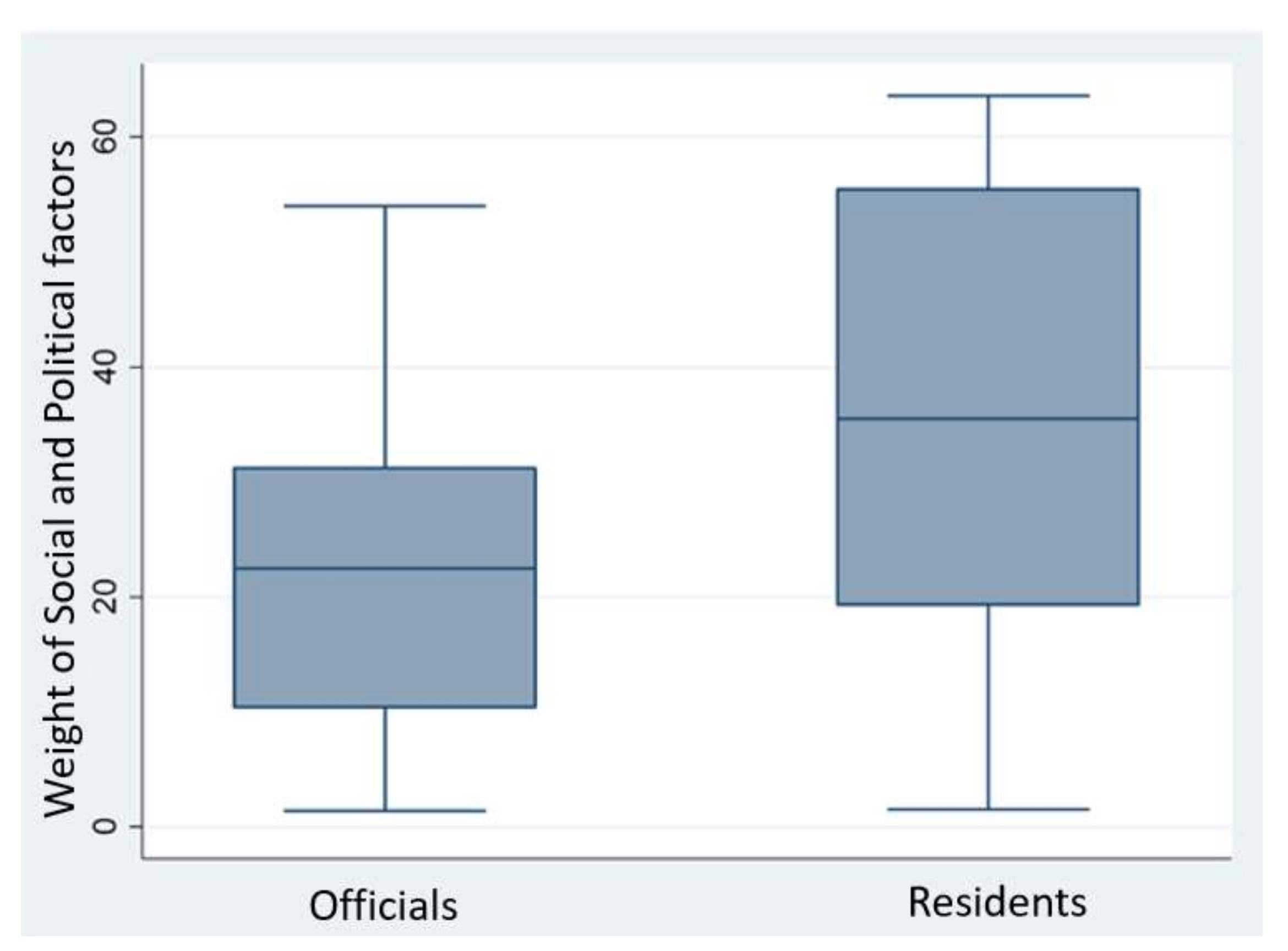1. Introduction
“Controversial facilities” is a concept widely used in public policy and politics studies and practices. It refers to facilities which may result in hazards or the unreasonable allocation of risks and benefits [
1]. There are several kinds of controversial facilities; those most closely associated with sustainability are hazard or pollution risk facilities, such as chemical plants, nuclear power plants [
2,
3], and landfills [
4,
5]. Sustainability is a multidimensional concept involving economic, environmental, and social factors [
6]. Controversial facilities are at the hub of these three factors; while they are essential to economic development, they remain risky owing to their negative impact, and are thus opposed by local residents. Controversial facilities may face protests or even clashes with nearby residents as part of a phenomenon referred to as not-in-my-back-yard (NIMBY) syndrome [
7,
8,
9]. Disputes or even conflicts caused by controversial facilities are a barrier to regional sustainability. Making the facilities more acceptable could help to achieve balanced sustainability for economic growth and social progress.
Perceptions of benefits and risks seem to be the original cause for controversy. China is witnessing high-speed economic growth and keen demand for controversial facilities, which have collided with the dense population in various cities. Consequently, narrow and state-centered approaches to regulating such facilities lead to conflicts, protests, and even violence [
10,
11]. Government officials always play an important role in controversial facility programmes [
12]. Because of different perspectives, local officials who take part in decision-making or consultation processes may have different perceptions of controversial facilities than the public [
13,
14]. Officials always concentrate on the overall utility and hazards of facilities, while the public not only focuses on their immediate surroundings but also on the risk and uncertainty involved [
15,
16,
17]. Perceptions of risks and benefits result in behaviour, which, combined with the non-equivalence of decision-making power and negative externalities, makes conflicts actually occur [
4,
14,
18,
19]. Conflicts between economic development and social stability generated by perception biases concerning controversial facilities may also fundamentally affect the sustainability of the region.
This paper concentrates on perception biases towards facilities and aims to clarify the similarities and differences in risk and benefit perceptions of controversial facilities between officials and the public. To compare the weights of risk and benefit perceptions between these two groups, a psychological model called Social Judgement Theory (SJT) was used. Also, a unique experimental method of measurement was executed along with the SJT model to measure the weight of risks and benefits in accepting controversial facilities by different people. Such a measurement method not only reveals one’s weighting of risk and benefit perceptions when making a decision, it is also more accurate in comparing the degree of perception among individuals.
The outline of this paper is as follows.
Section 2 puts forward a series of hypotheses based on the literature.
Section 3 explains the methodology of Social Judgement Theory and the data used in this paper.
Section 4 presents the results.
Section 5 investigates how the risk and benefit perceptions of controversial facilities differ between local officials and the public. Finally,
Section 6 concludes with a summary of the findings, an interpretation of the results, and an assessment of the broader lessons.
3. Method and Data
3.1. Method: Social Judgement Theory
To make a comparison of the weighting of different elements, we opted to use SJT, which is both a model of cognition and an approach used to study cognitive conflict. The theory was developed by Hammond [
31,
32,
33] based on the Lens model [
34]. SJT assumes that individuals perceive subjects through certain cues. When people rely on the weight of these cues to make judgements, they may deviate from the objective truth, which results in cognitive biases. Cues and their weight also vary from person to person, which results in cognitive conflict or biases in perception [
35]. We used the dual-system model developed by Cooksey (
Figure 1) to measure the perceptive biases between different groups of people [
35]. The SJT method is a small-sample research method which represents each participant’s cognitive system using a regression model. Researchers establish the regression model by surveying the weight that participants give to different cues and analysing the intersubjective cognitive conflicts. Because our research objects were difficult to access, we wanted to accurately measure their cognition of the controversial facility to study the cognitive conflicts of different groups of people. SJT is more a quasi-experimentation and psychological measurement approach than a social survey method; it focuses on cognitive differences and conflicts between participants. Thus, this type of measurement is not suitable for analyses and comparisons using large samples.
To ensure that the participants had specific perceptions of the chemical plant, we conducted a case study. If we had done a survey in a region without a chemical plant, then the subjects would have had quite different chemical plants in mind based on their own experiences. Some scholars have suggested that researchers should separate proposed facilities from established ones. Once a facility is established, residents are likely to be more supportive of it, because their lives have been changed [
21]. Therefore, we decided to conduct the survey in an area where there was a risky chemical plant. In this context, we knew that both officials and residents would have specific perceptions of the risks and benefits of the plant.
3.2. The Case and Background
The X chemical plant, which is a pollution enterprise that had experienced accidents years ago in the administrative region of the L city government, was selected as a case. The names of the chosen plant and the city it is located in are anonymized to protect them from possible damage to reputation. L city is located in the west of Shandong, China. As the pillar industry of L city, the X plant has not only made a great contribution to L city’s economic development, but also created many job opportunities and tax revenues, and many other enterprises rely on it.
However, the plant is not safe for two reasons: industrial accidents (sometimes explosions) and chronic pollution. In recent years, two accidents have occurred. The first was a flash explosion which had only a limited effect, but the second involved a big explosion and a significant economic loss. In terms of pollution, the technicians at the plant insist that the production process is scientific, safe, and legal, but local officials consider that argument not entirely credible. Residents have noticed a pungent smell around the plant and significantly contaminated water being discharged. The main products of the X chemical plant include vitriol and chemical fertilizers, some of which are toxic, so industrial chemical leaks caused by accidents may also lead to pollution. Apparently, environmental pollution does exist, and the risks caused by the plant are real and widely known by the locals.
3.3. Cues and Model
Controversial facilities may have complex impacts on the surrounding environment. One of the most fundamental impacts is that the facilities may drive down house prices nearby, which is an important economic impact, as other research has indicated [
21]. Hunter and Leyden argued that controversial effects, rather than being attributable to concerns such as property values and aesthetics, depend mainly on two factors: fear of potential health effects and distrust in the government’s management [
36]. Thus, factors related to controversial facilities possibly involve at least three aspects: economic benefit factors, social–political factors, and environmental health factors. These three factors are all involved in the case of the X chemical plant.
3.3.1. Economic Benefit Factors
Controversial facilities can have economic impacts on the surrounding residents. Experience from southern China shows that controversial facilities with hazard and pollution risks will affect house prices, which means a prominent economic effect on nearby residents [
37]. However, such facilities may not relate to house prices in the case of the X plant, because houses in nearby villages cannot be traded. There is no market for houses in villages, so their value or price is meaningless. Thus, the main factors become economic compensation, employment opportunities, and the economic development of the region. Scholars have found that some communities are faced with a difficult dilemma: they support the employment and economic benefits that come with controversial facilities, but they are reluctant to accept hazardous and noxious facilities [
28]. We added four economic benefit factors to make this more specific for participants to understand: a one-time relocation allowance, indirect economic feedback, employment opportunities, and regional industry planning.
3.3.2. Environmental Health
Chemical plants can create both water and air pollution at the same time, and waste treatment also matters. In terms of water pollution, a chemical plant can pollute both groundwater and surface water, such as rivers. As for air pollution, a chemical plant can make the air not only visibly turbid, but also invisibly pungent. Accidental explosions could also aggravate the pollution problem because of the leakage of harmful material. In addition, pollution or environmental risks are often limited in scope, so the distance from the facility to the residents is an important factor [
38]. Four second-grade indexes related to environmental health were added: distance, water pollution, a waste disposal method, and additional indicators.
3.3.3. Social and Political Factors
Researchers have observed that the public does not protest controversial facilities, but protests against the decision-making institution instead [
39]. Therefore, the controversial facilities are related to government PR (public relations) and public decision-making. In China, the most common form of public decision-making is public hearings. Trust in facilities consists of trust in the technological installations and the relevant parties’ ability to operate the installations. Trust in the government, however, also consists of trust in policies and laws. Three factors were added as second-grade indexes to make this specific.
3.3.4. A Table of Indexes for Further Understanding
Previous research has indicated that it is better to design fewer than five cues when using SJT [
35]. For simplicity, we chose three cues: economic benefits, environmental health, and social–political factors. The participants were unable to make judgements with only these phrases. To aid their understanding, we provided a table of indexes to the participants before they responded to the questionnaire (see
Table 1). The table consists of three grades of indexes. The first two grades, as mentioned previously, are mainly simple names of factors, while the third-grade indexes give details based on the second-grade indexes.
3.4. Measurement and Data
Based on measurements under SJT, we chose “economic benefit”, “environment and health”, and “social and political factors” as cues to elicit 15 profiles; the participants then gave their judgements on the cues’ respective acceptability. Before the formal questionnaire, we provided a table to show the specific contents of the three cues (as shown in
Table 1). However, we did not reveal the second-grade indexes when surveying in order to avoid information overload. As mentioned previously, SJT is not suitable for analyses and comparisons using large samples, especially for an accurate analysis of cognitive distinctions. Therefore, this study did not follow random sampling principles, but focused on the importance of status in the local government and nearby communities. In terms of government officials, we selected seven officials who contacted the local chief executives most frequently from the Municipal Party Committee Office of L City as well as four main executives of the town near the X Plant. In addition, there were six officials from the Development and Reform Commission (which is responsible for formulating economic development strategies) and eight Administration of Work Safety officials, who are responsible for safety supervision. Among the villagers, we invited participants who enjoyed a good reputation and possessed leadership qualities. We invited 11 cadres from the village near the plant as well as 15 young, successful businessmen. As there had been some accidents, the local government officials were sensitive to such a survey. To ensure reliability and confidentiality, we only gathered information about the gender, educational background, and age of the participants (see
Appendix A).
To avoid error, we designed a rule to eliminate unqualified participants. We treated the goodness of fit (R-square) of the regression equation as standard, and used it to express the judgement of specific participants. Details of the indicators are described below. If the R
2 was higher than 0.7, we considered the participants to have understood the meaning of the subject, and made a reliable judgement. We kept such samples with an R
2 higher than 0.7, and ruled out the others. In the end, we obtained a sample set with 17 local residents and 20 officials. All of the statistics and analyses are based on the qualified sample set (
Table 2).
We tested the differences of the two groups on the three main demographic variables. Significant differences (p < 0.05) were found between the two groups on sex ratio (χ2 = 4.78, p = 0.03), age (t = 6.70, p = 0.00), and education level (t = 4.44, p = 0.00). However, that did not result from sampling bias, as the subjects were not selected via random sampling, but by their importance in the two groups. It was indicated that the number of males was obviously higher than females in both groups. The educational level of the official group was obviously higher than the other group, and the official participants were also younger than the resident participants.
Based on the Lens model, a questionnaire for the SJT method is something like a graphical questionnaire (see
Figure 2). As a general rule, the number of profiles was 5 times the number of cues. We generated 15 groups of cues using random numbers (see
Appendix B). In order to avoid multicollinearity, we measured the correlation between the three cues. The correlation coefficient between X1 and X2 is 0.1; the correlation coefficient between X2 and X3 is also 0.1, and the correlation coefficient between X1 and X3 is 0.25. The results showed that there was no significant correlation between the cues. Consequently, the respondents only needed to make judgements about their acceptance of these profiles. We obtained 15 sets of profiles with cues and judgements, and thereby conducted a regression analysis using the software POLICY PC (pexc3, Executive Decision Services LLC, Albany, NY, USA), which was specially designed for the SJT method. As the software generated the results, we obtained the weight of each cue for each subject.
5. Discussion
The central argument of this paper concerns the perception biases between government officials and the public towards controversial facilities, and aims to clarify the similarities and differences in their perceptions of controversial facilities’ risks and benefits. Consequently, we set up four hypotheses, the first three of which concentrate on the acceptance and perception of controversial facilities, while the last one concerns the similarities and differences between the two groups. Results indicate that H1 and H4 are verified, H3 is largely verified, and H2 is not verified. In terms of environmental health, all participant officials and locals agree that controversial facilities with higher environmental health levels are more acceptable, so H1 is proved. As for economic benefits, about 30% of the residents and nearly half of the officials do not agree that higher economic benefits can make the controversial facilities more acceptable, so H2 is not verified. With regard to social and political factors, 70% of the residents and 85% of the officials agree that if the social and political factors are dealt with more effectively, facilities may be more acceptable. That means H3 is also proved in general.
In verifying H4 and comparing the benefit and risk perceptions of the public and officials, the main argument of the study can be demonstrated by comparing the weight of cues. After comparing “economic benefits” and “social and political factors”, we found that local officials responsible for endorsing and supervising plants attached more significance to environmental factors than the local people around the plant, who focused more on social and political factors than the officials. There was no significant difference in their cognitive beliefs about economic benefits. Thus, it can be seen that there is a cognitive conflict between government officials and villagers regarding the same facility, and it is informed by the importance they place on different factors. This conflict does not exist between “economic benefits” and “social and political” cues, but instead between “social and political factors” and “environmental health” cues. Yet that appears to run counter to common sense: government officials prefer overall utility, and refer to economic benefits, whereas the public focuses on their surroundings, such as residential environmental quality [
15,
16,
17]. In contrast, most officials, as members of society, may dislike polluters more. Social and political factors, such as a relocation allowance and policy legitimacy, might also be important factors leading to conflicts, which confirms the findings of previous research [
11,
24,
25].
From another perspective, it might be false and even misleading to use the ‘official-people’ dichotomy when siting controversial facilities. We can offer two possible explanations for such a result. On the one hand, in the former hypothesis, we considered officials and residents as two different groups. If we take them as one group, we find that the officials have a relatively higher income and are well-educated and younger. They are likely to be post-materialists who possess a more intense consciousness towards protecting the environment. On the other hand, residents’ perceptions and interests in their daily lives are more direct and short term, while pollution and safety risks are often chronic and hard to detect. In addition, officials not only make judgements according to rational analyses, but have more information and knowledge [
40].
For regional sustainability, the siting and management process of controversial facilities should be more carefully conducted. That means closing up the gap in perception biases between officials and the public in terms of facility location and supervision. As results have proved in China, controversial facilities are not entirely unacceptable to residents. When controversial facilities have been built, and once irrational emotions have dissipated, we may find that there is no significant difference in the weight placed on economic benefits between residents and officials. However, this does not mean that residents can be bribed with money. As residents focus more on social and political factors, they expect more fairness in facility building. In China at present, there are no effective formal communication channels, or a fair distribution of benefits and risks, between the public and the government [
10,
11]. The so-called communication is mostly limited to propaganda, which means the public enjoys little “discourse power” [
29]. A formal communication mechanism, reasonable benefit distribution, and fair institutional arrangements may be solutions to conflicts over siting or NIMBYism.
It is also necessary to take more concrete actions to mitigate cognitive biases so as to bring about the positive effects of the controversial facilities and promote sustainable development in the region. First of all, builders and managers should reinforce public relations to change perceptions concerning region-friendly design and construction [
41]. Second, the experience of water governance in southern China indicates that an effective cooperation network with government is essential to rational sustainability in China [
42]. Finally, after controlling for the negative effects of the controversial facilities, managers should raise awareness of the positive effects of such facilities and turn issues into resources [
43].
As a possible origin of the NIMBY syndrome, the benefit and risk perceptions of controversial facilities in China are worthy of investigation. It is important to begin more extensive and in-depth studies in the field of cognitive conflict. Broader fields of study and more detailed factors will need to be involved in future studies. Meanwhile, when studying controversies and crisis management in China, the complicated bureaucratic administrative system cannot be ignored. This study delivered preliminary findings on cognitive conflicts between officials and residents with a small sample, but the specific reasons and impacts are left to future studies.









